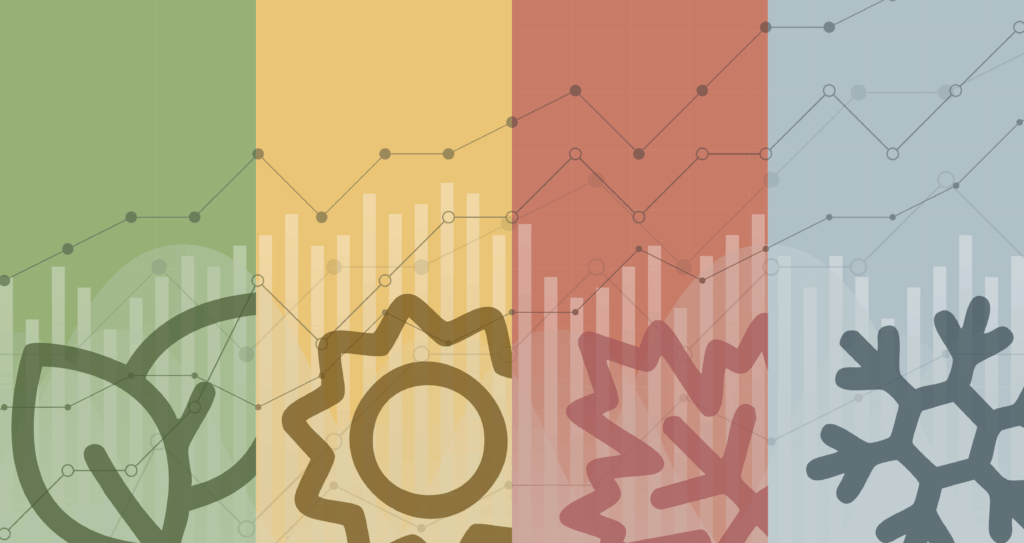In the context of CPG and FMCG, seasonality refers to the fluctuations in demand for certain products based on the time of year, weather, traditions, holidays, annual occurrences, or specific events. Imagine a perfectly unseasonal product: demand is consistent every day of the year. Sales of this imaginary product in Q1 are exactly equal to those of Q2, Q3, and Q4. A chart of weekly sales trended over time would have no variation. In reality, all products experience some degree of seasonality, but some are much more exaggerated than others.
Before we continue, what are some examples of seasonal and unseasonal products? According to 52 weeks of sales data from the Natural Channel from January to December 2024, the top three least seasonal subcategories were Shelf-Stable Liquid Drink mixes (think: Mio), Pre-Workout supplements, and Frozen Plant-Based Burgers. These products had the least variation in sales from quarter to quarter. On the opposite end of the spectrum, the subcategories with the most seasonal sales variation were Cranberries, Pumpkins & Gourds, and Frozen Plant-Based Loaves and Roasts (think: Tofurky or Field Roast).
Finally, seasonality can manifest itself in strange ways. Grocery stores sometimes see a dip in weekly sales during the summer due to customers eating out, going on vacation, or not wanting to heat up their house with a stove or oven; this phenomenon of lower overall store sales in summer is often called the “summer bummer.” But of course, some products thrive in summer, like ice cream, sunscreen, and bug spray.
Understanding the seasonality of a brand, product, or category is important for the following reasons:
Product Adjustments and Limited Editions
-
- Flavors & Ingredients: CPG companies often introduce limited-time flavors or seasonal ingredients that match consumer tastes at different times of year. For example, pumpkin spice in the fall, peppermint in winter, or fresh fruit flavors in summer.
- Packaging: They may also release special packaging to align with holidays or seasonal themes, which can boost appeal and drive sales.
Placement, Promotions & Advertising
-
- Seasonal Promotions: CPG companies increase marketing efforts around key seasonal periods (like holidays, summer, or back-to-school) through ads, discounts, and promotions. These campaigns are designed to build anticipation and drive sales.
- Targeted Advertising: Using data and analytics, brands target specific consumer segments with seasonally relevant messaging via social media, email, and digital ads.
- Strategic Placement: In stores, CPG companies often work with retailers to secure prime shelf space during peak seasons, such as end caps or special displays.
- Increased Distribution: They may also push more inventory to certain retail channels (e.g., online platforms, supermarkets, or convenience stores) depending on the time of year.
Inventory and Supply Chain Management
-
- Forecasting Demand: Companies closely track sales patterns from previous years to forecast demand and ensure they have the right amount of product available for peak seasons.
- Stocking Up: For highly seasonal items, companies may ramp up production and distribution in advance to ensure they can meet higher demand without running into out-of-stock problems.
Putting Seasonality To Work
Pretend you are a brand manager of an ice cream brand. You want to understand the seasonality of the category and the competition and translate those insights into a sound business strategy. What are the first steps you should take?
- Trending Unit and Promoted Volume
- Build a combination chart in Excel that looks at the last year or two of weekly sales for the entire subcategory, either at a specific retailer or for a banner or business unit. Put unit volume on one axis as bars and promoted unit volume as a line on a secondary axis. What do you see?
- What weeks were the highest and lowest in sales?
- What general times of year are busy or slow, and do they correspond to external events like holidays?
- Are there defined patterns in the promoted volume? If so, that suggests that many brands put their products on sale at the same time. Could pre-empting those sales with your own sale help you?
- Build a combination chart in Excel that looks at the last year or two of weekly sales for the entire subcategory, either at a specific retailer or for a banner or business unit. Put unit volume on one axis as bars and promoted unit volume as a line on a secondary axis. What do you see?
- Reviewing Seasonal Flavors
- Build another set of charts in Excel that uses the Flavor attribute. For the first one, look at the data in an aggregated fashion and review the performance of each flavor. Vanilla, Chocolate, and Strawberry are the top flavors in volume, but they won’t be contracting or shrinking much. Are there obscure or interesting flavors that are growing by leaps and bounds? Perhaps Caramel Apple is +100% in units versus a year ago.
- Next, trend out the caramel apple’s performance over time. When is it maximally popular? Could you make a Caramel Apple flavor and launch it during that time? See how much Caramel Apple ice cream was sold and ask yourself if you could capture 10% of those sales (aka market share). Would it be worth it?
- Finding Gaps
- Trend the data similar to flavor, but invert your perspective. When do ice cream flavor sales slump? Perhaps it’s during Q1 when everyone is busy executing their New Year’s Resolutions and dieting. Could you develop a low-calorie product that would appeal to dieters and help hedge your sales losses during Q1?
Some products at the grocery store are 100%, unapologetically seasonal: think Christmas trees. No one’s buying that in July, no matter how good your marketing team is. But the majority of brands and products have some sort of subtle-to-obvious seasonal bend in sales. As a business owner, operator, analyst, or stakeholder, it is up to you to discover and exploit these areas of opportunity.





